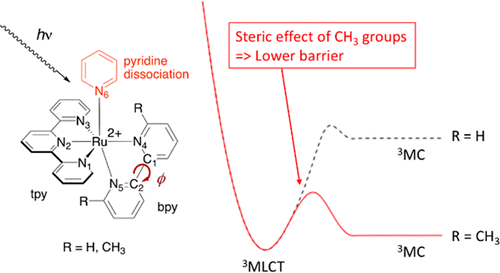当前位置:
X-MOL 学术
›
Inorg. Chem.
›
论文详情
Our official English website, www.x-mol.net, welcomes your
feedback! (Note: you will need to create a separate account there.)
DFT Investigation of Ligand Photodissociation in [RuII(tpy)(bpy)(py)]2+ and [RuII(tpy)(Me2bpy)(py)]2+ Complexes
Inorganic Chemistry ( IF 4.3 ) Pub Date : 2017-12-19 00:00:00 , DOI: 10.1021/acs.inorgchem.7b02398 Khalin Nisbett 1 , Yi-Jung Tu 1 , Claudia Turro 2 , Jeremy J. Kodanko 1 , H. Bernhard Schlegel 1
Inorganic Chemistry ( IF 4.3 ) Pub Date : 2017-12-19 00:00:00 , DOI: 10.1021/acs.inorgchem.7b02398 Khalin Nisbett 1 , Yi-Jung Tu 1 , Claudia Turro 2 , Jeremy J. Kodanko 1 , H. Bernhard Schlegel 1
Affiliation

|
Photoinduced ligand dissociation of pyridine occurs much more readily in [Ru(tpy)(Me2bpy)(py)]2+ than in [Ru(tpy)(bpy)(py)]2+ (tpy = 2,2′:6′,2″-terpyridine; bpy = 2,2′-bipyridine, Me2bpy = 6,6′-dimethyl-2,2′-bipyridine; py = pyridine). The S0 ground state and the 3MLCT and 3MC excited states of these complexes have been studied using BP86 density functional theory with the SDD basis set and effective core potential on Ru and the 6-31G(d) basis set for the rest of the atoms. In both complexes, excitation by visible light and intersystem crossing leads to a 3MLCT state in which an electron from a Ru d orbital has been promoted to a π* orbital of terpyridine, followed by pyridine release after internal conversion to a dissociative 3MC state. Interaction between the methyl groups and the other ligands causes significantly more strain in [Ru(tpy)(Me2bpy)(py)]2+ than in [Ru(tpy)(bpy)(py)]2+, in both the S0 and 3MLCT states. Transition to the dissociative 3MC states releases this strain, resulting in lower barriers for ligand dissociation from [Ru(tpy)(Me2bpy)(py)]2+ than from [Ru(tpy)(bpy)(py)]2+. Analysis of the molecular orbitals along relaxed scans for stretching the Ru–N bonds reveals that ligand photodissociation is promoted by orbital mixing between the ligand π* orbital of tpy in the 3MLCT state and the dσ* orbitals that characterize the dissociative 3MC states. Good overlap and strong mixing occur when the Ru–N bond of the leaving ligand is perpendicular to the π* orbital of terpyridine, favoring the release of pyridine positioned in a cis fashion to the terpyridine ligand.
中文翻译:

DFT研究[Ru II(tpy)(bpy)(py)] 2+和[Ru II(tpy)(Me 2 bpy)(py)] 2+配合物中的配体光解离
吡啶的光诱导配体解离在[Ru(tpy)(Me 2 bpy)(py)] 2+中比在[Ru(tpy)(bpy)(py)] 2+中更容易发生(tpy = 2,2': 6′,2″-吡啶; bpy = 2,2′-联吡啶,Me 2 bpy = 6,6′-二甲基-2,2′-联吡啶; py =吡啶)。已使用BP86密度泛函理论研究了这些配合物的S 0基态以及3 MLCT和3 MC激发态,其中SDD基集,Ru的有效核心电势和6-31G(d)基集用于其余化合物。原子。在这两种配合物中,可见光和系统间交叉激发都会产生3MLCT状态,其中来自Ru d轨道的电子已被提升为三联吡啶的π*轨道,然后在内部转化为解离3 MC状态后释放出吡啶。甲基与其他配体之间的相互作用导致[Ru(tpy)(Me 2 bpy)(py)] 2+中的应变明显大于[Ru(tpy)(bpy)(py)] 2+中的应变。S 0和3 MLCT状态。过渡到解离的3 MC状态释放了此应变,从而导致从[Ru(tpy)(Me 2 bpy)(py)] 2+的配体解离的势垒比从[Ru(tpy)(bpy)(py)] 2更低的势垒+。沿着松弛扫描扫描分子轨道以拉伸Ru–N键的分析表明,配体的光解离是通过3 MLCT状态的tpy的配体π*轨道与表征3 MC状态的dσ*轨道之间的轨道混合来促进的。当离去配体的Ru–N键垂直于三联吡啶的π*轨道时,会发生良好的重叠和强烈的混合,有利于将吡啶以顺式方式释放到三联吡啶配体上。
更新日期:2017-12-19
中文翻译:

DFT研究[Ru II(tpy)(bpy)(py)] 2+和[Ru II(tpy)(Me 2 bpy)(py)] 2+配合物中的配体光解离
吡啶的光诱导配体解离在[Ru(tpy)(Me 2 bpy)(py)] 2+中比在[Ru(tpy)(bpy)(py)] 2+中更容易发生(tpy = 2,2': 6′,2″-吡啶; bpy = 2,2′-联吡啶,Me 2 bpy = 6,6′-二甲基-2,2′-联吡啶; py =吡啶)。已使用BP86密度泛函理论研究了这些配合物的S 0基态以及3 MLCT和3 MC激发态,其中SDD基集,Ru的有效核心电势和6-31G(d)基集用于其余化合物。原子。在这两种配合物中,可见光和系统间交叉激发都会产生3MLCT状态,其中来自Ru d轨道的电子已被提升为三联吡啶的π*轨道,然后在内部转化为解离3 MC状态后释放出吡啶。甲基与其他配体之间的相互作用导致[Ru(tpy)(Me 2 bpy)(py)] 2+中的应变明显大于[Ru(tpy)(bpy)(py)] 2+中的应变。S 0和3 MLCT状态。过渡到解离的3 MC状态释放了此应变,从而导致从[Ru(tpy)(Me 2 bpy)(py)] 2+的配体解离的势垒比从[Ru(tpy)(bpy)(py)] 2更低的势垒+。沿着松弛扫描扫描分子轨道以拉伸Ru–N键的分析表明,配体的光解离是通过3 MLCT状态的tpy的配体π*轨道与表征3 MC状态的dσ*轨道之间的轨道混合来促进的。当离去配体的Ru–N键垂直于三联吡啶的π*轨道时,会发生良好的重叠和强烈的混合,有利于将吡啶以顺式方式释放到三联吡啶配体上。















































 京公网安备 11010802027423号
京公网安备 11010802027423号